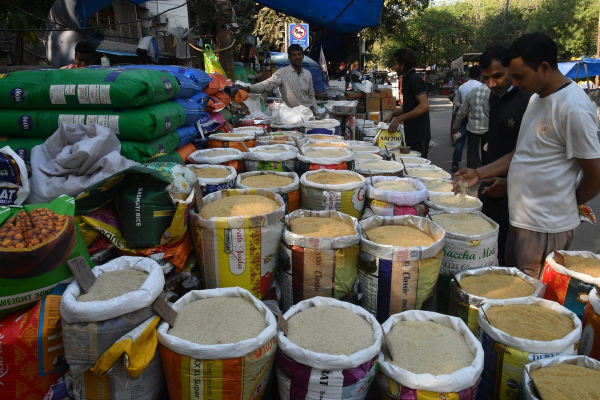Inflation stays flat at 5.09% in February against 5.1% in January
While the overall CPI number is still above the Reserve Bank of India's 4% target, core inflation, which measures the non-food and non-fuel portion of the CPI
- by B2B Desk 2024-03-13 11:01:18
India's CPI inflation remained stable at 5.1% in February, and food inflation rose slightly but was offset by a slowdown in core and fuel inflation.
India's benchmark inflation figure, as measured by the Consumer Price Index, remained flat between January and February. The headline inflation figure in the retail sector was 5.09% in February, compared to a reading of 5.1% in January 2024. The CPI for January and February, if read with the recent cut of Rs 100 in LPG cylinder prices, will be seen in the March inflation figures - meaning the CPI will be close to the Reserve Bank of India's forecast of 5% for the quarter ending March 2024. The figure February inflation rate is also in line with analysts' expectations. A Bloomberg survey of economists expected this figure to reach 5.05%.
While the overall CPI number is still above the Reserve Bank of India's 4% target, core inflation, which measures the non-food and non-fuel portion of the CPI basket, fell to 3.37%, according to the database of the Center for Monitoring Indian Economy. (CMIE). This is the lowest level of core inflation since November 2019 and indicates that the Indian economy is far from overheating at this point.

To be sure, food inflation rose marginally from 8.3% in January to 8.6% in February. This largely reflects the sharp rise in prices for eggs, fish and meat, as this category saw inflation rise from 1.6% in January to 5.7% in February. To be sure, food inflation rose marginally from 8.3% in January to 8.7% in February. This largely reflects the sharp rise in prices for eggs, fish and meat, as this category saw inflation rise from 1.6% in January to 5.7% in February. The inflation rate for vegetables also rose from 27.1% in January to 30.3% in February
While inflation for cereals and pulses fell marginally from January levels, future inflation expectations for these items will depend on the winter harvest. There are unofficial reports that western disturbances that brought rain in parts of northern and northwestern India may have damaged some crops.
In another series of indicators published by the National Statistics Office, the industrial production index for January fell slightly below analysts' expectations. At 3.8%, international investment growth in January was 30 basis points (a basis point is one-hundredth of a percentage point) below Bloomberg's forecast and also below the 4.25% for December 2023. More than three-quarters of the international investment basket grew, 3.2% in January, compared to 4.5% in December 2023. While the latest IVI figures are in line with expectations that growth will lose some momentum in the quarter ending March, caution is needed. Read it as a sign of a significant slowdown in economic momentum in the manufacturing sector. The Manufacturing PMI, another high-frequency indicator widely used by analysts, shows that the manufacturing sector actually gained economic momentum in January and February compared to December 2023 levels and remained in expansion territory.
"CPI inflation remained stable at 5.1% in February. Food inflation rose moderately but was offset by a sustained slowdown in core and fuel inflation. "Food price inflation increased moderately, but was offset by a sustained slowdown in core and fuel inflation. "said Rahul Bajoria, Managing Director and Head of Emerging Markets Economics, Asia (ex-China). "We expect the RBI to begin policy easing from 3Q 24, as it awaits further signs from food prices, drawing comfort from benign core inflation and robust growth."
Also Read: 8i Ventures launches seed funding initiative 'Origami' to back early-stage startups

POPULAR POSTS
Loan EMIs to Drop as RBI Slashes Repo Rate - Full MPC December 2025 Highlights
by Shan, 2025-12-05 11:49:44
Zoho Mail vs Gmail (2025): Which Email Platform Is Best for Businesses, Startups, and Students?
by Shan, 2025-10-09 12:17:26
PM Modi Launches GST Bachat Utsav: Lower Taxes, More Savings for Every Indian Household
by Shan, 2025-09-24 12:20:59
$100K H-1B Visa Fee Explained: Trump’s New Rule, Clarifications & Impact on Indian Tech Workers
by Shan, 2025-09-22 10:11:03
India-US Trade Deal Soon? Chief US Negotiator Arrives in Delhi as Talks Set to Begin Tomorrow
by Shan, 2025-09-15 11:54:28
Modi Meets Xi: Trump’s Tariffs, Strategic Autonomy, and the Future of Asia’s Power Balance
by Shan, 2025-09-03 06:40:06
Google Claims Gemini AI Uses Just ‘Five Drops of Water’ Per Prompt, Sparks Debate
by Shan, 2025-08-22 12:34:27
RECENTLY PUBLISHED

Pine Labs IPO 2025: Listing Date, Grey Market Premium, and Expert Outlook
- by Shan, 2025-11-05 09:57:07

The Agentic Revolution: Why Salesforce Is Betting Its Future on AI Agents
- by Shan, 2025-11-05 10:29:23

Top 10 Insurance Companies in India 2026: Life, Health, and General Insurance Leaders Explained
- by Shan, 2025-10-30 10:06:42

OpenAI Offers ChatGPT Go Free in India: What’s Behind This Big AI Giveaway?
- by Shan, 2025-10-28 12:19:11

Best Silver Investment Platforms for 2025: From CFDs to Digital Vaults Explained
- by Shan, 2025-10-23 12:22:46





 Subscribe now
Subscribe now 